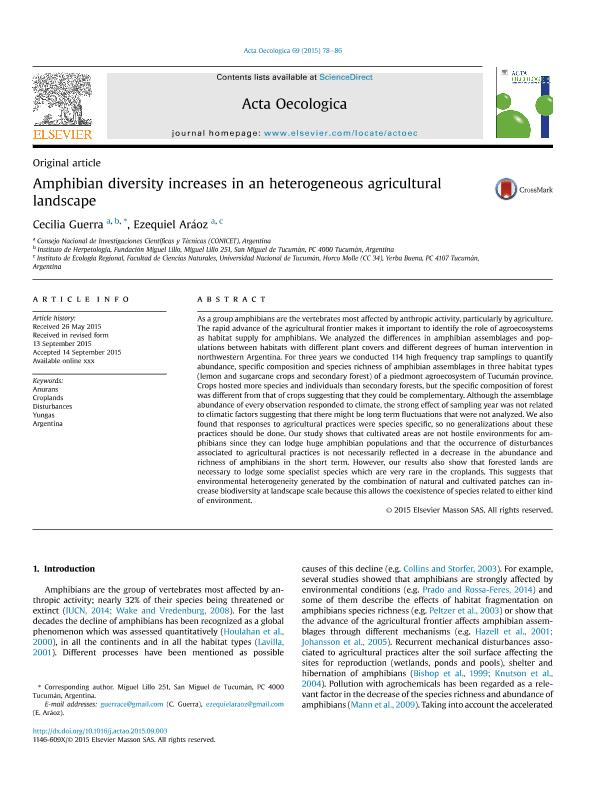Mostrar el registro sencillo del ítem
dc.contributor.author
Guerra, Cecilia

dc.contributor.author
Aráoz, Ezequiel

dc.date.available
2017-02-03T19:35:08Z
dc.date.issued
2015-11
dc.identifier.citation
Guerra, Cecilia; Aráoz, Ezequiel; Amphibian diversity increases in an heterogeneous agricultural landscape; Elsevier Masson; Acta Oecologica; 69; 11-2015; 78-86
dc.identifier.issn
1146-609X
dc.identifier.uri
http://hdl.handle.net/11336/12471
dc.description.abstract
As a group amphibians are the vertebrates most affected by anthropic activity, particularly by agriculture. The rapid advance of the agricultural frontier makes it important to identify the role of agroecosystems as habitat supply for amphibians. We analyzed the differences in amphibian assemblages and populations between habitats with different plant covers and different degrees of human intervention in northwestern Argentina. For three years we conducted 114 high frequency trap samplings to quantify abundance, specific composition and species richness of amphibian assemblages in three habitat types (lemon and sugarcane crops and secondary forest) of a piedmont agroecosystem of Tucumán province. Crops hosted more species and individuals than secondary forests, but the specific composition of forest was different from that of crops suggesting that they could be complementary. Although the assemblage abundance of every observation responded to climate, the strong effect of sampling year was not related to climatic factors suggesting that there might be long term fluctuations that were not analyzed. We also found that responses to agricultural practices were species specific, so no generalizations about these practices should be done. Our study shows that cultivated areas are not hostile environments for amphibians since they can lodge huge amphibian populations and that the occurrence of disturbances associated to agricultural practices is not necessarily reflected in a decrease in the abundance and richness of amphibians in the short term. However, our results also show that forested lands are necessary to lodge some specialist species which are very rare in the croplands. This suggests that environmental heterogeneity generated by the combination of natural and cultivated patches can increase biodiversity at landscape scale because this allows the coexistence of species related to either kind of environment.
dc.format
application/pdf
dc.language.iso
eng
dc.publisher
Elsevier Masson

dc.rights
info:eu-repo/semantics/openAccess
dc.rights.uri
https://creativecommons.org/licenses/by-nc-nd/2.5/ar/
dc.subject
Anurans
dc.subject
Croplands
dc.subject
Disturbances
dc.subject
Yungas
dc.subject
Argentina
dc.subject.classification
Ciencias Medioambientales

dc.subject.classification
Ciencias de la Tierra y relacionadas con el Medio Ambiente

dc.subject.classification
CIENCIAS NATURALES Y EXACTAS

dc.title
Amphibian diversity increases in an heterogeneous agricultural landscape
dc.type
info:eu-repo/semantics/article
dc.type
info:ar-repo/semantics/artículo
dc.type
info:eu-repo/semantics/publishedVersion
dc.date.updated
2017-02-03T14:00:43Z
dc.journal.volume
69
dc.journal.pagination
78-86
dc.journal.pais
Francia

dc.journal.ciudad
Paris
dc.description.fil
Fil: Guerra, Cecilia. Fundación Miguel Lillo. Dirección de Zoología. Instituto de Herpetología; Argentina. Consejo Nacional de Investigaciones Científicas y Técnicas; Argentina
dc.description.fil
Fil: Aráoz, Ezequiel. Universidad Nacional de Tucumán. Facultad de Ciencias Naturales E Instituto Miguel Lillo. Instituto de Ecología Regional; Argentina. Consejo Nacional de Investigaciones Científicas y Técnicas; Argentina
dc.journal.title
Acta Oecologica

dc.relation.alternativeid
info:eu-repo/semantics/altIdentifier/doi/http://dx.doi.org/10.1016/j.actao.2015.09.003
dc.relation.alternativeid
info:eu-repo/semantics/altIdentifier/url/http://www.sciencedirect.com/science/article/pii/S1146609X15300187
Archivos asociados
